Body Shop Vitamin C Sheet Mask Review
Buicks of the 1950-1953 period have become American icons in the tradition of Coca-Cola machines, Route 66 signs, and Standard Crown gas pump globes. No other car symbolizes postwar promise and prosperity like the bulbous, toothy Buick. The ubiquitous Buick offered a model for every buyer in most every price class. In the days when the buck stopped with Harry Truman, and well into the Eisenhower years, Buick absolutely dominated the American automobile scene above the Chevy-Ford-Plymouth trio. GM's Flint, Michigan, division did it with a combination of bold styling, innovative marketing, and a dealer organization second to none.
Classic Cars Image Gallery
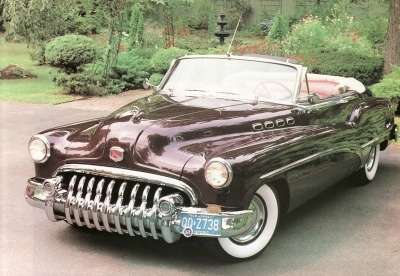
This 1950 Buick Roadmaster convertible is just one of many
classic cars that Buick was known for in the 50s.
See more pictures of classic cars.
For 1948 and 1949, GM provided a very unique and advanced C-body for the Oldsmobile 98 and Cadillac. Actually, it had originally been designated the B-body, but became the C-body late in the game. In any case, Buick passed on it for 1948, then adopted it for 1949, for reasons that have never been made entirely clear.
Most likely, Buick's powerful general manager, Harlow Curtice, felt that his division -- the most successful of the three -- didn't need a radical and untested body to further improve sales in 1948. This so-called P-38 body was developed by designer Frank Hershey under the strong influence of GM styling czar, Harley Earl. It was directly inspired by the Lockheed P-38 Lightning airplane, and the key to its design was a high belt-line, but not quite up to the windowline, running in a straight line from the front of the vehicle to the very rear.
The P-38 was developed as a Cadillac, with Olds stylists executing their own distinctive version. Chevrolet and Pontiac developed their own much smaller A-bodies a year later, and the Olds 76 and 88 also used it.
The larger C-body ended up being an extremely controversial design with dealers, top management, and especially with the Buick Division, which adapted it for only one short year. The prevailing feeling seemed to be that it was just too radical a design for GM's top-end cars. It has been said that Harlow Curtice, who moved up into GM corporate management at the end of 1948, and finally to the GM presidency in 1953, was particularly lukewarm to the P-38 body. Curtice was succeeded at Buick by Ivan L. Wiles. While not as great a leader as Curtice, Wiles still had the "old man" to lean on.
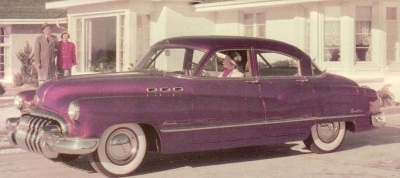
Buicks in the 50s, like this Super Touring Sedan
were all about curves.
Considering the mood in the top echelons at GM, it's easy to see why B- and C-bodies would be all-new for 1950. Carrying this scenario a step further, the Buick Division would obviously have a very strong say in 1950 B- and C-body design. Now this was the era of the rounded body, seen in fullest flower in the "bathtub" Packard, Lincoln Cosmopolitan, Hudson, and Nash.
Looking at this trend with the high fenderline and often no rear fenders at all, Harley Earl decided to move away from the crowd in 1950 by dropping the fenderline and adding a distinctive dip to accentuate the rear fenders. To a degree, he was going back to the 1942-1948 Buick and his own 1938 Buick Y-Job show car.
This didn't bother Earl in view of corporate pressures and his own desire to break from 1948 to 1949 styling. It should also be noted that Earl was simultaneously developing the LeSabre and XP-100 "dream cars," which carried the same general fenderline as the 1950 production cars.
For more information on cars, see:
- Muscle Cars
- Sports Cars
1950s Buick Styling
It would be easy to argue that the experimental/show cars were the basis for the 1950 Buick production cars. But that's not quite the way things happen in Detroit. We are talking about a prevailing styling theme in the GM studios in the late Forties.
Moreover, with the 1950 models, management was trying to develop three distinctive makes of cars with a minimum of unique body stampings, but still with very individual styling. Thus was born the most complex and ingenious body interchangeability program in all GM history to date. Furthermore, it could easily be argued that the 1950 GM upper-level cars were as much the products of body engineering as of new design.

The 1950 Buick Super wore the new C-body.
Consider how Buick used the new body. Two different straight-eight engines dictated two front-end lengths, the Roadmaster being 4.75 inches longer than the Super and Special. Some have argued that all 1950 Buicks wore C-bodies, even the Special. The fact is, however, that all 1950 Buicks had B-bodies, except for the longer-wheelbase Super and Roadmaster Riviera four-door sedans -- the ones with the rear-quarter windows.
These two models got the Cadillac C-body, wherein the roof was stretched and the whole rear end was moved back four inches for more rear-passenger space as well as a noticeably longer look. To enhance the length, the distinctive bodyside sweepspear that first appeared in mid-1949 followed the contour of the rear roofline. Arguably, these svelte Buick sedans looked better than the Cadillac, which must have pleased Curtice greatly.
Although the Roadmasters were a bit shorter than GM's finest, they had the illusion of looking longer because of the chrome side treatment and the fact that the Buick's wheels were nearer to the extremities of the car. Even the name, adopted in 1936, pumped up the car's image, because the Roadmaster was, as Buick put it, "haughtily superior to road conditions."
With two different front ends and two different sedan lengths, Buick ended up with four very different-looking models out of essentially two bodies -- one of the keys to Buick sales success in the early Fifties. It should also be noted that of the three GM makes using the new 1950 bodies, Buick flaunted the most extreme rear-fender dip to further set it apart from the more conservative Cadillac and the "Futuramic" Olds. Fenders for all three makes were detachable. Incidentally, the Oldsmobile 98 used the B-body, not the C-body.
The basic concepts of GM's 1950 program were continued up to 1954, when the GM B- and C-bodies were completely redone again. By this time, more money was available to further differentiate the three makes. Fenders were fully integrated with the bodies, short decks became longer, and hoods and trunks were flatter and more individually stylized.
Since Ned Nickles, Harley Earl, Bill Mitchell, Charlie Chayne, Harlow Curtice, and most anybody else who played a key role in the 1950 Buick program are no longer with us, any speculation on how the car actually came about comes to us either secondhand or by trying to put all the pieces of the puzzle together. The 1945-1952 era was a somewhat void period in Buick styling.
Some sources say that Ned Nickles became head of Buick styling in 1945. Henry Lauve claims he was head of Buick styling at that time. He contends that when he moved up the ladder to head GM corporate styling in 1947, he appointed Nickles as his successor. Lauve claims he had a strong hand in designing the 1950 Buick, and takes all the credit for the famous "bucktooth grille." However, he can no longer recall any details of the project. We believe that the 1950 Buick was a joint effort of Buick's best design, production, and engineering minds at the time, including -- but not limited to -- Lauve.

Henry Lauve created the famous
Buick bucktooth grille.
The toothy bumper/grille was originally considered for the LeSabre show car when it was still a Buick and not a GM design. Both the sweepspear and the "VentiPorts" were Ned Nickles's trademarks on the 1949 Buick, although their origins may go much farther back. All of the exterior trim was a very well-executed 1950 version of styling themes that had been associated with Buick since the early Forties. The instrument panel returned to the 1942-1948 theme, after Buick had gone to a much more aircraft-inspired design for 1949.
For more information on cars, see:
- Muscle Cars
- Sports Cars
1950 Buick
Proof of Buick's leadership in the 1950 GM body program was the 1950 Special, riding a 121.5-inch wheelbase. Introduced on August 8, 1949, it was the first GM make and model to carry the bold new styling to the public. It even preceded the Buick Super and Roadmaster by several months.
At the time of the Special's debut, only fastbacks -- or "Jet-backs," as Buick called them in 1950 -- were offered: a two-door and four-door in standard trim and in a DeLuxe sub-series. Priced at $1,856 for the standard two-door (also often called "Sedanet") and $1,909 for the four-door, Buick was now poised to give Plymouth a run for the Number Three position in sales.
Also listed was a business coupe, a fastback sans back seat, priced at just $1,803. A few months later, when the Super and Roadmaster models were introduced, the Special series added a notchback four-door "Touring Sedan" in both standard and DeLuxe trim.
The Specials were so popular that close to 82,000 copies were sold before the 1949 calendar year ended. Buick output in the 1950 calendar year leaped an incredible 38 percent to 552,827 units, due in great measure to the success of the Special. More amazing was model-year production: up 104.8 percent, assisted by the early introduction of the new Special (although some ended up being titled as '49s).
Total Special output came to 338,331, or nearly half of all the 670,256 Buicks produced for the 1950 model run. That year Buick held an 8.2-percent share of the U.S. auto market -- not quite up to Plymouth, but pushing it very hard. Although Buick actually built more cars than Plymouth for the model year, it couldn't quite unseat Plymouth in sales.

The Buick Super was offered
in the 1950 Estate Wagon.
The Super was built on the same 121.5-inch wheelbase as the Special, and shared the same body. It was offered as a four-door Touring Sedan (Buick also used the term "Tourback" in the early Fifties), two-door Jetback, convertible, Estate Wagon with partial wooden body, and, for the first time, a Riviera hardtop coupe.
Another addition to the Super series for 1950 was an impressive-looking Riviera four-door sedan riding a longer 125.5-inch wheelbase and sharing its C-body with the Roadmaster. Priced at only $73 more than the Touring Sedan, it was twice as popular.
Roadmasters, on a 126.25-inch wheel-base, came as a four-door, four-window sedan; two-door Jetback; convertible; Riviera hardtop; DeLuxe Riviera hardtop; and Estate Wagon. All of these Roadmasters used the same basic body as the Specials and Supers, but with a longer wheelbase and hood. In addition, there was the Model 72: a Riviera C-body four-door sedan boasting a 130.25-inch wheelbase.
This year, all Roadmasters sported the sweepspear, but the Riviera sedan and Estate Wagon didn't get it until midyear. Self-shift Dynaflow, first introduced in 1948, was standard on Roadmasters and optional elsewhere; 85 percent of all 1950 Buicks had it.

Buick's success in 1950 was due in
part to the Riviera hardtop.
A second reason for Buick's sales success in 1950 was the variety of Riviera hardtops. Production of the pillarless coupe jumped from 4,314 Roadmasters in 1949 to 56,030 Super Rivieras, 2,300 Roadmasters, and 8,432 Roadmaster DeLuxes, for a total of 66,762 hardtops for 1950. This was second only to the new Chevrolet Bel Air (by about 10,000 units), and represented one-quarter of the total hardtop market that year.
A few notes about the 1950 Buick are in order. Portholes, the VentiPorts, became flattened ovals and moved from the front fenders onto sides of the hood: four on each side for Roadmasters, three for Supers and Specials. Windshields for the Super and Roadmaster were one-piece units, but back windows remained three-piece on all notchback models. Windshields for the Special continued with two-piece construction.
Only Roadmasters merited the sweepspears; Special DeLuxes and Supers still featured the plainer straight-line bodyside trim, while base Specials wore none at all. Among 1950 Buick improvements were better visibility, wider seats, and a substantially shorter turning radius. Of particular interest to collectors should be the 1950 Super and Roadmaster Jetback coupes. With 10,697 and 2,968 built, respectively, they're far rarer than the Riviera hardtops today.
While the 1950 Buick's styling curves were as modern as Jane Russell's latest gown, the engineering was as tried-and-true as Clark Gable's smile. Buick saw no reason (at this point) to follow Oldsmobile and Cadillac into the short-stroke V-8 era. Its long-stroke, valve-in-head "Fireball" straight-eights still had plenty of appeal to the Buick crowd.
"Valve-in-head, ahead in value," was the advertising cry. The Roadmaster's 320.2-cubic-inch eight could be traced back to 1936, the Special's 248-cid unit to 1937. For 1950, the Roadmaster got a two-horsepower bump, to 152. The Special developed 115/120 horses, up five with stick-shift, 10 with Dynaflow.
The Super, which had formerly shared a slightly hotter Special engine, received a new variant, the F-263 (actually 263.3 cid): a bored version of the Special's straight-eight designed to operate on the new postwar higher-octane fuels. It produced 124 horses with stickshift, 128 with Dynaflow. Beginning in 1951, the 263 was shared with the Special (120/128 bhp), and was retained for the Special for 1953 -- the year the Roadmaster and Super adopted an all-new 322-cid ohv V-8.
For more information on cars, see:
- Muscle Cars
- Sports Cars
1951 Buick
The big visual change for Buick in 1951 was a return to the 1948 grille's theme of closely spaced vertical bars, but with a bumper "dipped" in the middle to better show off the shiny dental work. Neither dealers nor insurance companies had liked the toothy 1950 grille because every one of its nine pieces was different, making it difficult to stock and expensive to replace. And there were plenty of replacements because the teeth overlapped the bumper.
Moreover, the 1950 Buick grille bore the brunt of every radio comedian's jokes, which didn't sit well with Buick's humorless top management. Another change was the return to round VentiPorts, moved back to the front fenders, as in 1949. And, of course, the "bombsight" hood ornament first seen in 1946 still guided the driver down the road, though in a more stylized form.
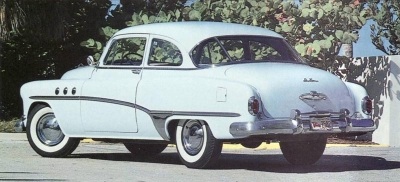
A Buick DeLuxe, such as this one,
was added to the Special series in 1951
Fastbacks were dropped from the Special series, but two notchback two-door sedans were added: a $2,127 DeLuxe, and a sparsely trimmed $2,046 Sport Coupe. A $2,561 convertible was added, too, but was outsold by both the Super and Roadmaster ragtops.
Specials got a new and simpler instrument panel with two large dials in front of the driver, and the base models were now the only Buicks with a two-piece windshield. On the sides, they wore bright stainless trim on the lower rear fenders, not the full sweepspear as on the DeLuxes. Horsepower was raised to 120, or 128 with Dynaflow.
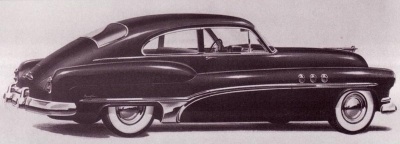
1951 was the last year for Buick Jetbacks.
Retaining the same lineup as in 1950, the Super now carried the full sweepspear on all models. However, this was the last year for Buick Jetbacks; only 1500 two-doors were produced, and only as a Super. Engines were unchanged for both Super and Roadmaster. In the Roadmaster line, the Jetback coupe departed.
The Riviera hardtop came in two models, with or without hydraulic window controls, and there was now only one four-door sedan, the 72R long-wheelbase Riviera. Total Buick model-year production for 1951 tumbled to 404,657 units, due in good part to Korean War cutbacks and a return to defense production. Buick nonetheless retained its fourth-place position, trailing Plymouth in production and sales.
For more information on cars, see:
- Muscle Cars
- Sports Cars
1952 Buick
For 1952 Buicks, changes were so minor that it takes a trained eye to tell a 1952 from a 1951. The Special standard models, which were phased out early in the model run, got a sweepspear, but kept a two-piece windshield. The easiest way to tell the model year from the sides was by the sweepspear, which changed slightly each year.
For 1952, it did not run the full length of the car. Instead, it flowed back to the rear wheel opening, then curved gracefully forward and rode along the rocker panel to the front wheel opening (the Special standards lacked the rocker panel strip). The 1952 Supers and Roadmasters also sported modest chrome rear-fender fins, and all 1952 Buicks (save wagons) featured a more squared-off decklid than in 1951.
The Special lineup remained unchanged from 1951, but the Super line listed only one four-door and one two-door, both Rivieras. Special and Super engines went unchanged, but the Roadmaster's Fireball eight was boosted to 170 horsepower -- via a compression ratio jump from 7.2:1 to 7.5:1 and a new Buick-designed four-barrel "Airpower" carburetor (that Olds and Cadillac borrowed for 1952, to Buick's displeasure). A much-needed option, power steering, was offered for the first time on Supers and Roadmasters, although priced at a whopping $199.
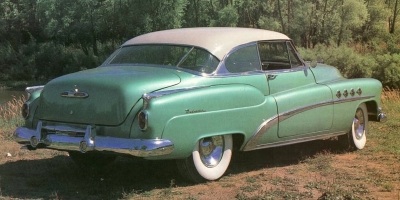
All 1952 Buicks, like this Roadmaster Riviera,
featured a more squared-off decklid
than 1951 models.
Ads for the 1952 Buick proclaimed that " ... a million dollars' worth of engineering, research and special components have gone into perfecting its ... Million Dollar Ride," while still providing "road-hugging security" in all conditions. "There's a special transverse radius rod extending from the frame on one side to the rear axle on the other side -- to control sidesway and 'side shift' on curves. And Buick shock absorbers have two sets of cylinders and pistons to control upsurge and down-thrust." Further, Buick made a point that its "honest heft" was offset by the Roadmaster's increased horsepower and that the new "Airpower carburetor needs less fuel at 40 [mph] than was formerly used at 30."
Still, production faltered to 303,745 units for the model year, again due primarily to Korean War production restrictions mandated by the government. But because other automakers were also forced to cut back by about the same proportion, Buick retained a solid fourth-place standing, a position it would keep for two more years, before finally taking over third.
Motor Trend evaluated a 1952 Buick Roadmaster sedan, now in its last year with the big 320.2-cid straight-eight. Lavishing some enthusiastic praise for a car fast going the way of the World War IIArmy tank, editor Harry Cushing pushed the ponderous Buick all the way from Flint, Michigan, to Ensenda, Baja, Mexico. His 0-60 time using Low and Drive came in at 17.1 seconds, top speed at 100 mph, while fuel economy at a steady 60 mph measured 12.6 mpg. He found the car so comfortable to drive at high speeds on primarily straight roads that in one day he drove the entire 756 miles between Eiko, Nevada, and Los Angeles.
His only real complaints about the car were a tendency to heel and break loose on curves when traveling at 70 to 75 mph, and the slow, slow Dynaflow. He noted that the mediocre cornering was the result of the softly sprung four-coil suspension. The Dynaflow, while smooth, required the use of both Drive and Low ranges in the mountains despite assurances from Buick officials back in Flint that this wouldn't be necessary. Even on straightaways, the editors weren't impressed with acceleration in Drive, especially when passing. And this was with the new four-barrel carburetor.
Cushing asked, "Have you ever wondered why Buick is one of the most popular cars in America? Take a cross-country trip in one. You will find it almost incomparable for comfort and luxury to your destination. Rabid car enthusiasts, lovers of sports cars, and other automotive fans at first may find this statement difficult to accept; but, to those who will take the time to step into a 1952 Buick Roadmaster and embark upon a piece of serious, constructive driving, it is a fact which will hit them as a pleasant surprise ... Buick has a remarkable hold on the American and world automobile market. Why? Because Buick has incorporated many desirable features into an automobile package which the car buying public demands: a design that appeals to many, smooth acceleration ... and a mattress type ride."
The reason why Buick was such a strong fourth in the industry for many years was the outstanding management and sales organization, which had the foresight to bring Buicks within the financial reach of nearly every new car buyer. In addition, Buick put almost as much emphasis on service as sales, and never lost sight of the importance of its dealer network.
Another secret of Buick's success was the advertising: never ponderous, and sometimes as light and lyrical as the old Jordan Playboy advertising of the Twenties. It was created by the Kudner Advertising Agency, which had held the account since Curtice had introduced a new "brand" of Buick way back in 1936.
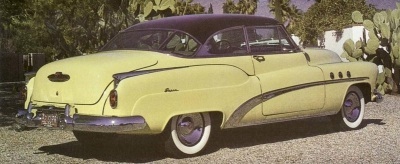
Simple and catchy advertising was used to
sell the 1952 Buicks like this Buick Super Riviera.
Buick's advertising slogan for many years was, "When better automobiles are built Buick will build them." Ads often added tag lines, like "Sure is true for '52." With the coming of the Buick overhead-valve V-8 in 1953, trendy new styling in 1954, and soon after the division's massive problems with styling and quality control, the 1950-1952 cars remain about as "better built" as older Buicks ever got.
For more information on cars, see:
- Muscle Cars
- Sports Cars
1950-1952 Buick Models, Prices, and Production
1950-1952 Buicks were some of the most desireable automobiles in the early 1950s. Find weight, production, and prices for 1950-1952 Buicks in the following chart.
1950-1952 Buick: Models, Prices, and Production
| 1950 Series 40 Special | Weight (lbs.) | Price | Production |
| 4d Touring Sedan | 3,710 | $1,941 | 1,141 |
| 4d DeLuxe Touring Sedan | 3,735 | 1,983 | 141,396 |
| 4d Jetback fastback sedan | 3,715 | 1,909 | 58,700 |
| 4d DeLuxe Jetback sedan | 3,720 | 1,952 | 14,335 |
| Jetback business coupe | 3,615 | 1,803 | 2,500 |
| DeLuxe Jetback coupe | 3,665 | 1,899 | 76,902 |
| Jetback fastback coupe | 3,655 | 1,856 | 42,935 |
| stripped chassis | -- | -- | 422 |
| Total Special | | | 338,331 |
| 1950 Series 50 Super | Weight | Price | Production |
| 4d Touring Sedan | 3,745 | 2,139 | 55,672 |
| Riviera 4d sedan | 3,870 | 2,212 | 114,745 |
| convertible coupe | 3,965 | 2,476 | 12,259 |
| Riviera hardtop coupe | 3,790 | 2,139 | 56,030 |
| Jetback fastback coupe | 3,645 | 2,041 | 10,697 |
| 4d Estate Wagon | 4,115 | 2,844 | 2,480 |
| stripped chassis | -- | -- | 539 |
| Total Super | | | 253,352 |
| 1950 Series 70 Roadmaster | Weight | Price | Production |
| 4d Touring Sedan | 4,135 | 2,633 | 6,738 |
| Riviera DeLuxe 4d sedan | 4,220 | 2,738 | 54,212 |
| Riviera hardtop coupe | 4,135 | 2,633 | 2,300 |
| Riviera DeLuxe hardtop coupe | 4,245 | 2,854 | 8,432 |
| convertible coupe | 4,345 | 2,981 | 2,964 |
| Jetback fastback coupe | 4,025 | 2,528 | 2,968 |
| 4d Estate Wagon | 4,470 | 3,407 | 420 |
| stripped chassis | -- | -- | 539 |
| Total Roadmaster | | | 78,573 |
| Total 1950 Buick | | | 670,256 |
| 1951 Series 40 Special | Weight | Price | Production |
| 4d sedan | 3,605 | 2,139 | 999 |
| DeLuxe 4d sedan | 3,680 | 2,185 | 87,848 |
| Riviera hardtop coupe | 2,645 | 2,225 | 16,491 |
| convertible coupe | 3,830 | 2,561 | 2,099 |
| 2d Sport Coupe | 3,600 | 2,046 | 2,700 |
| DeLuxe 2d sedan | 2,615 | 2,127 | 54,311 |
| stripped chassis | -- | -- | 1,106 |
| Total Special | | | 165,554 |
| 1951 Series 50 Super | Weight | Price | Production |
| 4d Tourback sedan | 3,755 | 2,356 | 10,000 |
| Riviera 4d sedan | 3,845 | 2,437 | 92,886 |
| convertible coupe | 3,965 | 2,728 | 8,116 |
| Riviera hardtop coupe | 3,765 | 2,356 | 54,512 |
| DeLuxe Jetback coupe | 3,685 | 2,248 | 1,500 |
| 4d Estate Wagon | 4,100 | 3,133 | 2,212 |
| stripped chassis | -- | -- | 3,009 |
| Total Super | | | 172,235 |
| 1951 Series 70 Roadmaster | Weight | Price | Production |
| Riviera 4d sedan | 4,240 | 3,044 | 48,758 |
| convertible coupe | 4,355 | 3,283 | 2,911 |
| Riviera hardtop coupe | 4,185 | 3,051 | 809 |
| Riviera hardtop coupe (with hydraulic controls) | 4,235 | 3,143 | 12,901 |
| 4d Estate Wagon | 4,470 | 3,780 | 679 |
| stripped chassis | -- | -- | 810 |
| Total Roadmaster | | | 66,868 |
| Total 1951 Buick | | | 404,657 |
| 1952 Series 40 Special | Weight | Price | Production |
| 4d sedan | 3,650 | 2,209 | 137 |
| DeLuxe 4d sedan | 3,665 | 2,255 | 63,346 |
| Riviera hardtop coupe | 3,665 | 2,295 | 21,180 |
| convertible coupe | 3,850 | 2,634 | 600 |
| 2d Sport Coupe | 3,605 | 2,115 | 2,206 |
| DeLuxe 2d sedan | 3,620 | 2,197 | 32,684 |
| stripped chassis | -- | -- | 745 |
| Total Special | | | 120,898 |
| 1952 Series 50 Super | Weight | Price | Production |
| Riviera 4d sedan | 3,825 | 2,563 | 71,387 |
| convertible coupe | 3,970 | 2,869 | 6,904 |
| Riviera hardtop coupe | 3,775 | 2,478 | 55,400 |
| 4d Estate Wagon | 4,105 | 3,296 | 1,641 |
| stripped chassis | -- | -- | 1,072 |
| Total Super | | | 136,404 |
| 1952 Series 70 Roadmaster | Weight | Price | Production |
| Riviera 4d sedan | 4,285 | 3,200 | 32,069 |
| convertible coupe | 4,395 | 3,453 | 2,402 |
| Riviera hardtop coupe | 4,235 | 3,306 | 11,387 |
| 4d Estate Wagon | 4,505 | 3,977 | 359 |
| stripped chassis | -- | -- | 226 |
| Total Roadmaster | | | 46,443 |
| Total 1952 Buick | | | 303,745 |
For more information on cars, see:
- Muscle Cars
- Sports Cars
Body Shop Vitamin C Sheet Mask Review
Source: https://auto.howstuffworks.com/1950-1952-buick.htm

0 komentar:
Posting Komentar